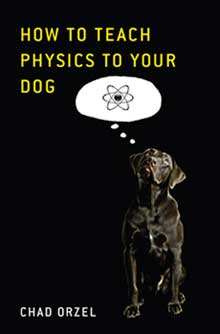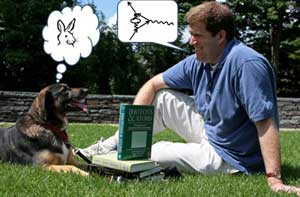How to Teach Physics to Your Dog
By Chad Orzel
The following is Excerpted from How to Teach Physics to Your Dog by Chad Orzel. Copyright © 2010 by Chad Orzel, Ph.D. Excerpted with permission by Scribner, a division of Simon & Schuster, Inc.

Bunnies Made of Cheese: Virtual Particles and Quantum Electrodynamics
Emmy is standing at the window, wagging her tail excitedly. I look outside, and the backyard is empty. "What are you looking at?" I ask.
"Bunnies made of cheese!" she says. I look again, and the yard is still empty.
"There are no bunnies out there," I say, "and there are certainly not any bunnies made of cheese. The backyard is empty."
"But particles are created out of empty space all the time, right?"
"You're still reading my quantum physics books?"
"It's boring here when you're not home. Anyway, answer the question."
"Well, yes, in a sense. They're called virtual particles, and under the right conditions, the zero-point energy of the vacuum can occasionally manifest as pairs of particles, one normal matter
and one antimatter."
"See?" she says, wagging her tail harder. "Bunnies made of cheese!"

The author and his dog. Photo credit: Matt Milless
"I'm not sure how that helps you," I say. "Virtual particles have to annihilate one another in a very short time, in order to satisfy the energy-time uncertainty principle. A virtual electron - positron pair lasts something like 10-21 seconds before it disappears. They're not around long enough to be real particles."
"But they can become real, right?" She looks a little concerned.
"I mean, what about Hawking radiation?"
"Well, sure, in a sense. The idea is that a virtual pair created near a black hole can have one of its members sucked into the black hole, at which point the other particle zips off and becomes real."
The tail-wagging picks back up. "Bunnies made of cheese!"
"What?"
She gives an exasperated sigh. "Look, virtual particles are created all the time, right? Including in our backyard?"
"Yes, that's right."
"Including bunnies, yes?"
"Well, technically, it would have to be a bunny-antibunny pair . . ."
"And these bunnies, they could be made of cheese."
"It's not very likely, but I suppose in a Max Tegmark* sort of ‘everything possible must exist' kind of universe, then yes, there's a possibility that a bunny-antibunny pair made of cheese (and anticheese) might be created in the backyard, but - "
"And if I eat one, the other becomes real." She's wagging her tail so hard that her whole rear end is shaking.
"Yeah, but they wouldn't last very long before they annihilated each other."
"I'm very fast."
"Given the mass of a bunny, they'd only last 10-52 seconds. If that."
"In that case, you'd better let me outside. So I can catch the bunnies made of cheese."
I sigh. "If you wanted to go outside, why didn't you just say that?"
"What fun would that be? Anyway, bunnies made of cheese!"
I look out the window again. "I still don't see any bunnies, but there is a squirrel by the bird feeder."
"Ooooo! Squirrels!" I open the door, and she goes charging outside after the squirrel, who makes it up a tree just in time.
Back in chapter 2, we saw that the wave nature of matter gives rise to zero-point energy, meaning that no quantum particle can ever be completely at rest, but will always have at least some energy. Incredibly, this idea applies even to empty space. In quantum physics, even a perfect vacuum is a constant storm of activity, with "virtual particles" popping into existence for a fleeting moment, thanks to zero-point energy, then disappearing again.
The idea of "virtual particles" popping in and out of existence in the middle of empty space is one of the most compelling and bizarre ideas in modern physics. In this chapter, we'll talk about quantum electrodynamics ("QED" for short), the underlying theory that gives rise to the idea of virtual particles. We'll also talk about the experiments that make QED arguably the most precisely tested theory in the history of science. Ironically, though, our discussion of this ultraprecise theory needs to start with the Heisenberg uncertainty principle.
* Max Tegmark is a cosmologist at MIT known for proposing that our universe is one of a vast number of universes in a larger "multiverse." According to Tegmark, this multiverse contains every possible kind of universe that can be described mathematically, even those that would make no sense to us. Tegmark's work is somewhat similar to the "modal realism" of the philosopher David Kellogg Lewis.
Buy the book from Amazon.











